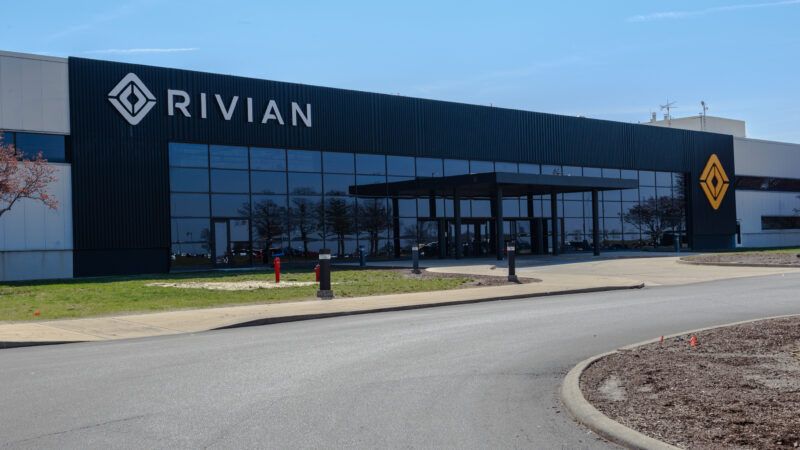Rivian Pauses Construction at Factory That Costs Georgia Taxpayers $1.5 Billion
The company will now build everything in its existing Illinois factory, pausing construction on the Georgia plant until "later."

Luxury electric automaker Rivian made several big announcements this week related to its expanding product line. At the same time, though, the company announced that it would pause construction on a factory in Georgia that received some of the most generous taxpayer-funded incentives in state history.
On Thursday, Rivian unveiled three new vehicles that will be available in the coming years. The company already offers the R1T and R1S, a luxury truck and SUV, respectively, which start at $70,000–$75,000 and can cost $100,000 or more. CEO R.J. Scaringe announced the R2, a smaller and more modest SUV that would be available in 2026 with prices starting at $45,000, as well as the R3 and R3X crossovers, also expected to be less expensive than the R1 series.
As Reason has documented, Rivian went public in November 2021, promising luxury electric vehicles that would be both stylish and rugged. The following month, the company—which only had a single factory in Illinois—struck a deal to build its second factory in Georgia: Rivian would spend $5 billion on the factory, and in exchange, Georgia state and local governments authorized up to $1.5 billion in tax credits and incentives.
In the years since, however, the company has struggled. In May 2023, Bloomberg reported that the company had lost 93 percent of its share value, and its market cap reflected "almost no value beyond the company's cash hoard." In the fourth quarter of 2023, the company lost $43,372 on each vehicle sold, up from a $30,648 per-vehicle loss in the third quarter.
Branching out into the more affordable R2 and R3 models is key to Rivian's long-term survival, opening up its product line to appeal to more than just those who can pay over $75,000 for a luxury vehicle. And to do this, it had to make some adjustments.
"To enable R2 to be launched earlier and with a considerable reduction in the capital required for its launch, Rivian plans to start production of R2 in its existing Normal, Illinois manufacturing facility," the company announced. It is also pausing construction in Georgia: "Rivian's Georgia plant remains an extremely important part of its strategy to scale production of R2 and R3. The timing for resuming construction is expected to be later to focus its teams on the capital-efficient launch of R2 in Normal, Illinois."
The move is expected to save the company $2.25 billion "as compared to the original forecast of launching the first line of R2 production at Rivian's Georgia site."
In October, the company announced that the Georgia site was "95 percent graded" and "nearly ready for construction to begin." Notably, under the incentive agreement, Georgia officials paid over $32 million for "clearing and grading" the site.
One year ago, almost to the day, Scaringe reaffirmed the company's dedication to the Georgia project, telling The Atlanta Journal-Constitution, "We're committed to this state and this project," adding that "the future of our company in terms of scaling and growing really relies on the future of this project. There's not another option. We're not planning an alternative. This must work."
The electric vehicle market, while growing, is in flux, due to softening consumer demand and persistently high interest rates. Just last month, Apple—the first company in history to ever record a $3 trillion valuation—canceled its decade-long quest to develop an electric car. General Motors and Ford have also rolled back pledged investments in electric vehicles.
In that sense, Rivian's pivot would be perfectly reasonable—companies must be free to adapt to changing circumstances in a way that benefits both their customers and their shareholders. But as with any central planning scheme, state economic incentives don't tend to allow for those sorts of dynamic pivots. In this case, Georgia officials mortgaged a large amount of taxpayer money on a plan that foresaw the company continuing on a path that no longer seems financially feasible.



Show Comments (26)